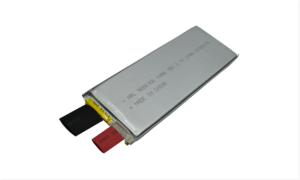The following is a detailed introduction to the advantages and disadvantages of polymer lithium batteries
1. Strengths:
(1) Good safety performance
The polymer lithium battery is structured with aluminum-plastic soft packaging, which is different from the metal shell of the liquid battery. Once a safety hazard occurs, the liquid battery is easy to burst, while the polymer battery will only blow up at best.
(2) The thickness is small and can be made thinner
Ultra-thin, the battery can be assembled for use in cards. Generally, liquid lithium batteries use the method of customizing the shell first, and then plugging the positive and negative materials. The thickness is below 3.6mm, and there is a technical bottleneck. Polymer batteries do not have this problem. It can be less than 1mm, which is in line with the current demand for mobile phones.
(3) Light weight
The battery using polymer electrolyte does not require a metal shell as an outer packaging for maintenance The polymer battery is 40% lighter than a steel shell lithium battery with equal capacity and 20% lighter than an aluminum shell battery.
(4) Large capacity
Polymer batteries have a capacity of 10~15% higher than steel shell batteries of equal size and 5~10% higher than aluminum shell batteries. They have become the first choice for color screen mobile phones and MMS mobile phones. Nowadays, most of the new color screen and MMS mobile phones on the market are also used. Polymer batteries, as well as large-capacity mobile power sources, are also composed of polymer batteries.
(5) Small internal resistance
The internal resistance of polymer batteries is smaller than that of ordinary liquid batteries. Now the internal resistance of domestic polymer batteries can even be below 35mΩ, which greatly reduces the self-consumption of the battery and prolongs the standby time of the mobile phone. Level in line with the world. This kind of polymer lithium battery that supports large discharge current is an ideal choice for remote control models, and it has become the most promising product to replace nickel-hydrogen batteries.
(6) The shape can be customized
Manufacturers need not be limited to standard shapes, and can economically make them into suitable sizes. The polymer battery can increase or reduce the thickness of the battery cell according to the needs of customers, and develop new battery cell types, which are cheap and short in mold opening cycle. Some can even be tailored to the shape of the mobile phone to make full use of the battery shell space and improve the battery. capacity.
(7) Good discharge characteristics
Polymer batteries use colloidal electrolytes, which are more stable than liquid electrolytes. Gel electrolytes have stable discharge characteristics and higher discharge channels.
(8) Simple design of maintenance board
Due to the choice of polymer materials, the battery core does not catch fire or burst, and the battery itself has sufficient safety. Therefore, the maintenance circuit design of the polymer battery can be considered to save the PTC and fuse, thereby saving the battery cost.
2. Defects:
Compared with lithium-ion batteries, the energy density and the number of cycles have decreased.
It is expensive to make.
There is no standard shape, and most batteries are made for the high-capacity consumer market.
Compared with lithium ion batteries, the price and energy are higher
Post time: Nov-03-2021





